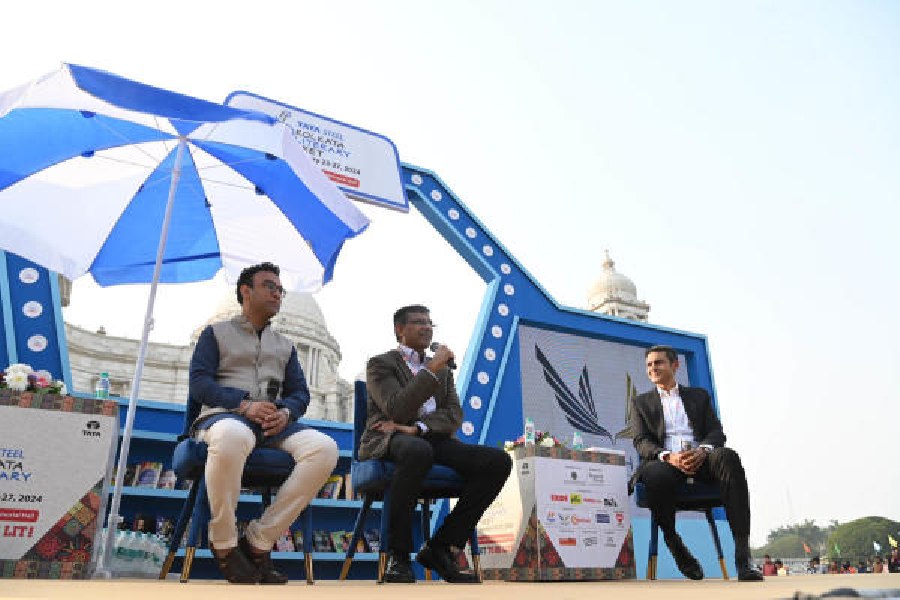Make economic growth inclusive and focus on designing products rather than just assembling them. Most importantly, preserve democracy.
A man who once shaped the monetary policy of India, and a fellow economist have co-authored a book that explains how India can accelerate economic development by investing in people’s human capital and manufacturing centred on innovative new products.
Raghuram Rajan, who was the governor of the Reserve Bank of India between 2013 and 2016, and Rohit Lamba, an assistant professor of economics at the Pennsylvania State University, discussed their book on Friday, Day IV of the Tata Steel Kolkata Literary Meet, in association with Victoria Memorial Hall and The Telegraph.
The book is titled Breaking the Mould: Reimagining India’s Economic Future.
“We have a vibrant democracy. Let us not kill that in an attempt to replicate China. China is the past. India is the future. But for India to be the future, let us recognise the strength our democracy gives. Because it allows the creativity, the discussion and ebullience that we need to become a truly innovative nation. We need that to become a developed nation by 2047,” said Rajan, now the Katherine Dusak Miller Distinguished Service Professor of Finance at the University of Chicago’s Booth School of Business.
Prime Minister Narendra Modi has set a target of making India a developed nation by 2047.
Rudra Chatterjee, the managing director of Luxmi Group and the chairman of Obeetee, and the moderator, asked the authors what “changes” were needed to achieve the goal.
Rajan then stressed the importance of inclusive growth.
Factoring in the current rate of growth and the annual rise in population, Rajan said the per capita income in India would be around $10,000 (Rs 8.3 lakh approximately) in 2047.
“That can still put us in lower-middle income in comparison to the rest of the world today. So, we need to grow faster. But not just faster at the top. We are doing very well among the upper middle class in this country today. But we need to grow everybody. That is the only way we will grow rich, when everybody grows and India grows,” said Rajan.
Ideate, not just assemble
India should aspire to conceptualise and design products rather than blindly follow the China model of assembling products, the authors said.
“A smart phone starts off at the high-end with conceptualisation, design and ideation. If you buy an Apple iPhone in the US, it says ‘designed in California’. It typically ‘doesn’t say made in China’. Why? Because design and ideation have a large component of profit embedded in the final product that you buy,” said Lamba.
The manufacturing of camera, microphone and bluetooth came further down the “smile curve” (which traces the value added of a finished product) and at the bottom was assembly, he said.
After the ideation, design and manufacturing came assembly, which has been happening in China for the past 20 years and now, increasingly, in India as well, he pointed out.
Further up in the smile curve were what Lamba called “allied services” like marketing, finance, iTunes and apps that are all embedded in the phone. “The highest value added is at the two ends of the value chain — in the conceptualisation, design and the allied services. Assembly, because of the competition involved in low-skill manufacturing, has very low value added,” he said.
Chatterjee argued that most companies that are in product development and marketing were mostly American or European.
Rajan countered that innovation and design is already happening in India but for multinational foreign companies.
“What we are asking is what can’t India create the firms that employ Indians to do what it does elsewhere in the world,” he said.
“What would it take,” asked Chatterjee.
Rajan said it would take Indian universities to start doing research that feeds into the entrepreneurs. “We need a university system which starts producing the kind of research which then gets passed to companies which can commercialise it. That is the way you start owning the products. We need to start thinking about how we create products in India. Because the value added is in the product. You own the product, you own the entire chain”.






